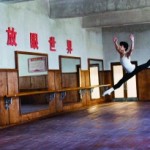Dance Review: Alvin Ailey in Boston: Stunning Integration of Past, Present, Future.
Alvin Ailey’s performance on Friday was spectacular: riveting, creative, beautiful and…fun!
The program, one of several in new director Robert Battle’s first directorial season, opened with Arden Court,

Alvin Ailey American Dance Theater's Antonio Douthit and Alicia Graf Mack in Paul Taylor's Arden Court. Photo by Paul Kolnik

Photo by Paul Kolnik
set to the baroque music of Richard Boyce and the most “classically” patterned of the evening’s pieces.
Described as “an unfolding petal” by Dance Magazine and as “lush” and lauded by the New York Times for “the irresistible pleasure of its dancing,” it is replete with big movements, high jumps, and elegant formations. This is the first season the Alvin Ailey company, founded in 1958, has performed a work by Paul Taylor.
Video: at http://www.alvinailey.org/arden-court
The second piece, Minus 16, by Israeli choreographer Ohad Naharin has been widely performed but it was a first for me–and one of the most unusual dance compositions I’ve ever seen.
It began during what seemed to be an intermission…with a dancer (Samuel Lee Roberts), wearing a poorly fitting black suit, seeming to be lackadaisically fooling around on stage..shuffle step, tap, to rumba and cha cha music… as if there were no audience. Gradually, more men in hats, black pants and T-shirts joined him.
In another part of Minus 16, members of the company dressed in black suits white t shirts sat on folding chairs in a semi-circle– swooping forward and leaning back, one after the other, in a clockwise wave– to a souped-up version of the passover song Echad Mi Yodea (one who knows). At the end of every repetition, and there were many, the dancer in the chair farthest right fell to the floor, taking longer and longer to return to his chair as the “wave” began again. Part way through, the dancers removed their jackets, and, at the end, they piled most of their clothes, including their shoes, at the center of the stage.

In the final piece of Minus 16, the dancers walked somberly and silently off the stage and through the performance hall– returning to the stage, still silent, escorting people from the audience who were then incorporated into the performance.
At first, I thought the audience members on stage were plants: some were great dancers; some were hams; some were both–and many of the women selected wore red tops or scarves and black skirts or slacks. But not all were so dressed and not all seemed comfortable being led by their professional partners, on stage.
The piece ended with all but one of the performers lying down on stage. The one left standing, a slightly overweight middle-aged blonde woman, bowed gracefully. The lights dimmed, and a spotlight shone on her as she walked across the stage, down the steps and through the hall to her seat. The audience–including me–loved it.
I’ve since read in Dance Magazine that if you want to be chosen to go on stage, you should wear bright colors; if not, bring a pen and pretend to be a critic by taking notes. And the Alvin Ailey Web site quotes Battle as saying that Minus 16 “offers surprising new experiences for the company and our audience,” and that it will be “both a great joy and a challenge for the dancers to improvise, break the fourth wall and invite the audience in.” So–the audience participation was for real.
The closing piece, Alvin Ailey’s 1960 Revelations, set to familiar “traditional” songs such as “Wade in the Water,” “Sinner Man,” and “Rocka My Soul in the Bosom of Abraham,”

Alvin Ailey American Dance Theater's Briana Reed and Yannick Lebrun in Alvin Ailey's Revelations. Photo by Gert Krautbauer

brought an encompassing sense of history to the entire performance. I had seen Revelations as a teenager…and now, as an adult, the variety of periods, costumes it incorporated got me thinking about the importance of art in integrating the past and present–and escorting us into the future.
–Anita M. Harris
Anita M. Harris is a writer and consultant based in Cambridge, MA. New Cambridge Observer is a publication of the Harris Communications Group, a PR and marketing communications firm.
 1.
1. 2.
2. 3. For example, Tseng Kwong Chi photographs Bill T. Jones Body Painting with Keith Haring; Fiona Banner copies life-drawing manuals, in which the figure often appears to be in flight; Silke Otto Knapp traces photographic images of dancers onto luminous silver-painted canvases, and Helena Almeida has herself photographed while she is drawing. 4.
3. For example, Tseng Kwong Chi photographs Bill T. Jones Body Painting with Keith Haring; Fiona Banner copies life-drawing manuals, in which the figure often appears to be in flight; Silke Otto Knapp traces photographic images of dancers onto luminous silver-painted canvases, and Helena Almeida has herself photographed while she is drawing. 4. 
 5.
5.